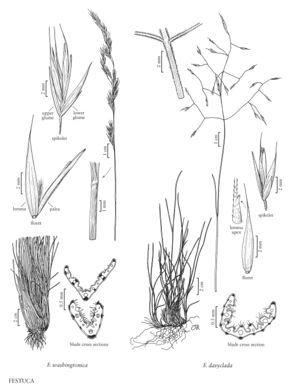Festuca washingtonica
Plants loosely or densely cespitose, without rhizomes. Culms 40-70 (100) cm, smooth, glabrous throughout; nodes usually not exposed. Sheaths closed for less than 1/2 their length, glabrous or scabrous, persistent or slowly shredding into fibers; collars glabrous; ligules (0.2) 0.3-0.5 mm; blades 1.5-3 mm in diameter, loosely conduplicate to flat, persistent, abaxial surfaces glabrous and smooth, adaxial surfaces scabrous or pubescent on the ribs, veins 7-13, ribs 7-10 (13), blades of the lower and upper cauline leaves similar in length and stiffness; abaxial sclerenchyma in strands opposite and about as wide as the major veins; adaxial sclerenchyma often present opposite the major veins; pillars or girders often developed. Inflorescences 8-12 (15) cm, loosely contracted, with 1-2 branches per node; branches lax, spreading or loosely erect, lower branches with 2+ spikelets. Spikelets 8-15 (18) mm, with (3) 4-6 (10) florets. Glumes exceeded by the upper florets, lanceolate to ovatelanceolate, scabrous distally; lower glumes (2) 3.5-5.5 mm; upper glumes (4) 5.5-7 (8) mm; calluses wider than long, glabrous, sometimes slightly scabrous; lemmas (5.5) 8-10 (11) mm, lanceolate, scabrous or puberulent at least distally, attenuate, sometimes minutely bidentate, awns 1-3 (3.5) mm, terminal or subterminal, straight, occasionally absent; paleas about as long as the lemmas, intercostal region scabrous or puberulent distally; anthers (3) 3.7-5.7 mm; ovary apices sparsely or densely pubescent. 2n = unknown.
Discussion
Festuca washingtonica grows in subalpine to low alpine regions of British Columbia and Washington. It has also been reported from Oregon and northern California; these records have not been verified.
Selected References
None.
Lower Taxa
"wider than long" is not a number."decumbent" is not a number."longest" is not a number.
